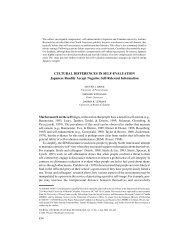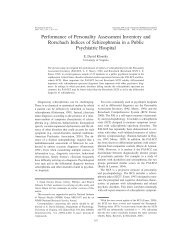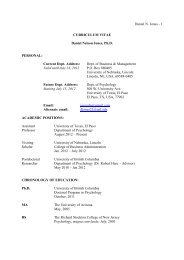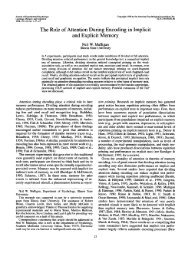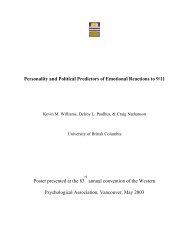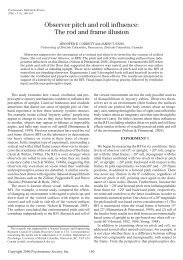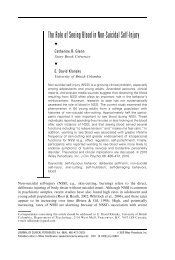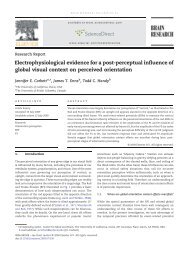Dynamic Social Impact and the Evolution of Social Representations ...
Dynamic Social Impact and the Evolution of Social Representations ...
Dynamic Social Impact and the Evolution of Social Representations ...
You also want an ePaper? Increase the reach of your titles
YUMPU automatically turns print PDFs into web optimized ePapers that Google loves.
Journal <strong>of</strong> Communication, Autumn 1996<br />
Symposium References<br />
Abelson, R. P. (1964). Ma<strong>the</strong>matical models <strong>of</strong> <strong>the</strong> distributions <strong>of</strong> attitudes under controversy. In N.<br />
Fredericksen & H. Gullicksen (Eds.), Contributions to ma<strong>the</strong>matica~psycho~o~y (pp. 142-160).<br />
New York: Holt, Rinehart & Winston.<br />
Abelson. R. P. (1979). <strong>Social</strong> clusters <strong>and</strong> opinion clusters. In P. W. Holl<strong>and</strong> & S. Leinhardt (Eds.),<br />
Pmpectives in social network research (pp. 233-2561, Reading, MA. Addison-Wesley.<br />
Abelson, R. P. 1995). <strong>Dynamic</strong>s <strong>of</strong> attitude extremity. In R. E. Petty & J. A. Krosnick (Eds.), Attitude<br />
strength: Antecedents <strong>and</strong> consequences (pp. 25-41). Hillsdale, NJ: Erlbaum.<br />
Abric, J. C. (1984). A <strong>the</strong>oretical <strong>and</strong> experimental approach to <strong>the</strong> study <strong>of</strong> social representations in<br />
a situation <strong>of</strong> interaction. In R. Farr & S. Moscovici (Eds.), <strong>Social</strong> representations (pp, 169-183).<br />
Cambridge, Engl<strong>and</strong>: Cambridge University Press.<br />
Anderson, N. H. (1971). Integration <strong>the</strong>ory <strong>and</strong> attitude change. Psychological Review, 78, 171-206.<br />
Ashmore, R. D. (1981). Sex stereotypes <strong>and</strong> implicit personality <strong>the</strong>ory. In D. L. Hamilton (Ed.),<br />
Cognitiueprocesses in stereotyping <strong>and</strong> intergroup behaoior (pp. 37-81). Hillsdale, NJ: Erlbaum<br />
Barton, S. (1994). Chaos, self-organization, <strong>and</strong> psychology. American PqJchologist, 49, 5-14<br />
Bavelas, A. (1948). A ma<strong>the</strong>matical model for group structures. Applied Anthropology, 7, 16-30<br />
Billig, M. (1993). Studying <strong>the</strong> thinking society: <strong>Social</strong> representations, rhetoric, <strong>and</strong> attitudes. In G.<br />
M. Breakwell & D. V. Canter (Eds.), Empirical approaches to social representations (pp. 39-62).<br />
New York: Oxford University Press.<br />
Blau, P. M. (1977). Inequality <strong>and</strong> heterogeneity. New York: Free Press.<br />
Blau, P. M., & Schwanz, J.E. (1984). Crosscutting social circles. New York: Academic Press<br />
Blumer, H. (1965). The future <strong>of</strong> <strong>the</strong> color line. In J. C. McKinney & E. T. Thompson (Eds.), The<br />
South in continuity <strong>and</strong> change (pp. 35-59). Durham, NC: Seeman.<br />
Boster, J. S. (1991). The information economy model applied to biological similarity judgment. In L.<br />
B. Resnick, J. M. Levine. & S. D. Teasley (Eds.), Perspectives on socially shared cognition (pp. 205<br />
225). Washington, DC: American Psychological Association.<br />
Boyd, R., & Richerson, P. J. (1994). The evolution <strong>of</strong> norms: An anthropological view.Journal <strong>of</strong><br />
Institutional <strong>and</strong> Theoretical Economics, 150, 72-87.<br />
Breakwell, G. M., & Canter, D. V. (Eds.) (1993). Empirical approaches to social represenfations. New<br />
York: Oxford University Press.<br />
Brunswik, E. (.1943). Organismic achievement <strong>and</strong> environmental probability. Psychological Reuiew,<br />
50, 255-272.<br />
Bun, R. S. (1982). Toward a structural <strong>the</strong>ory <strong>of</strong> action. New York: Academic Press<br />
Calhoun, J. B. (1963). The role <strong>of</strong> space in animal sociology.Journa1 <strong>of</strong>social Issues, 22, 47-55.<br />
Chaiken. S. (1980). Heuristic versus systematic information processing <strong>and</strong> <strong>the</strong> use <strong>of</strong> source versus<br />
message cues in persuasion. Journal <strong>of</strong>Personality <strong>and</strong> <strong>Social</strong> Psychology, 39, 752-766.<br />
Chaiken. S., & Eagly, A. H. (1976). Communication modality as a determinant <strong>of</strong> message persuasiveness<br />
<strong>and</strong> message comprehensibility. Journal <strong>of</strong> Personality <strong>and</strong> <strong>Social</strong> Psychology, 34, 605-<br />
614.<br />
Chaiken, S., & Eagly, A. H. (1983). Communication modality as a determinant <strong>of</strong> persuasion: The<br />
role <strong>of</strong> communicator salience. Journal <strong>of</strong>personality <strong>and</strong> <strong>Social</strong> Psychology, 45, 241-256.<br />
Cockburn, A. (1991). An introduction to evolutionaty ecology. Boston: Blackwell Scientific Publications.<br />
72



